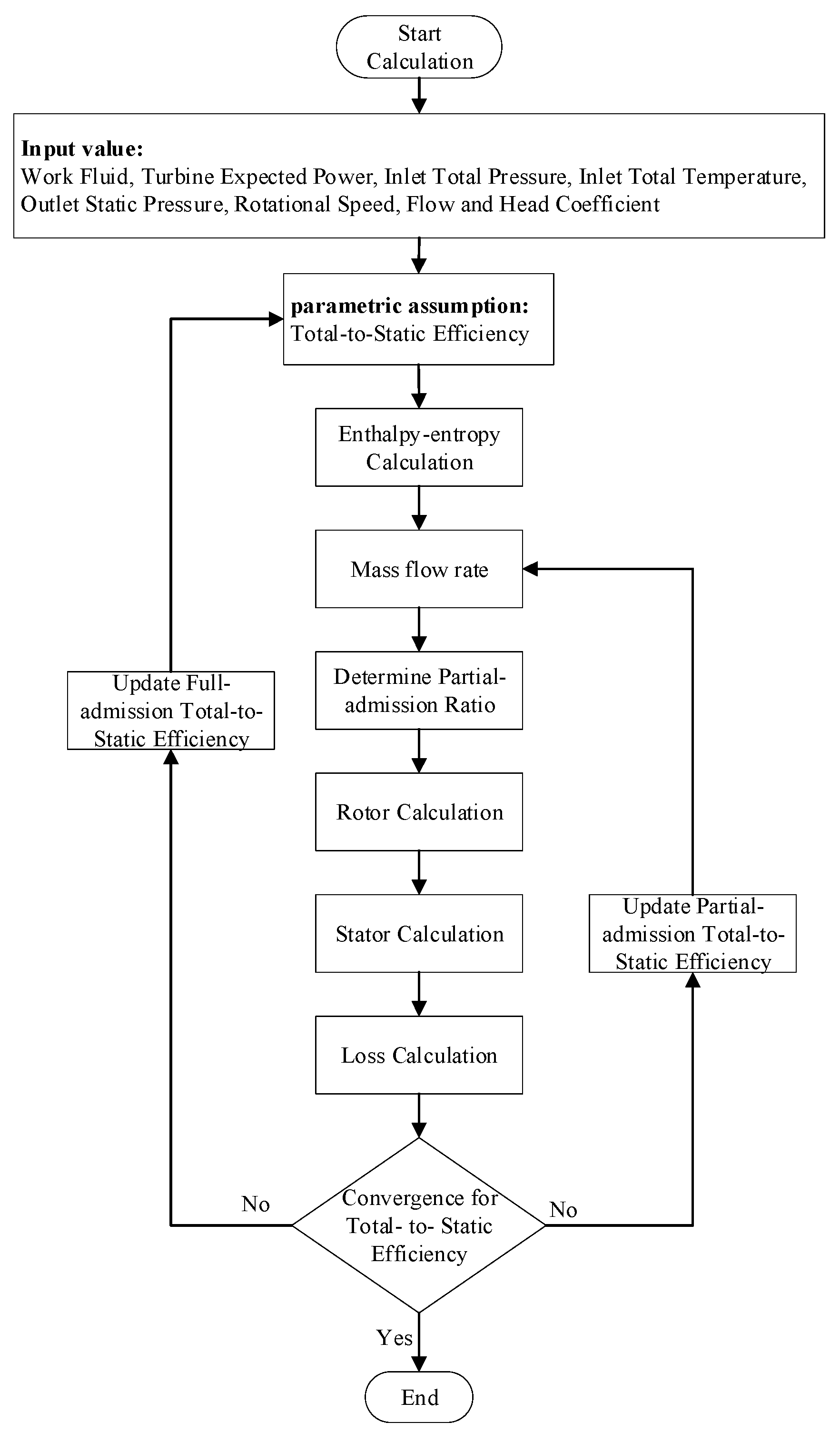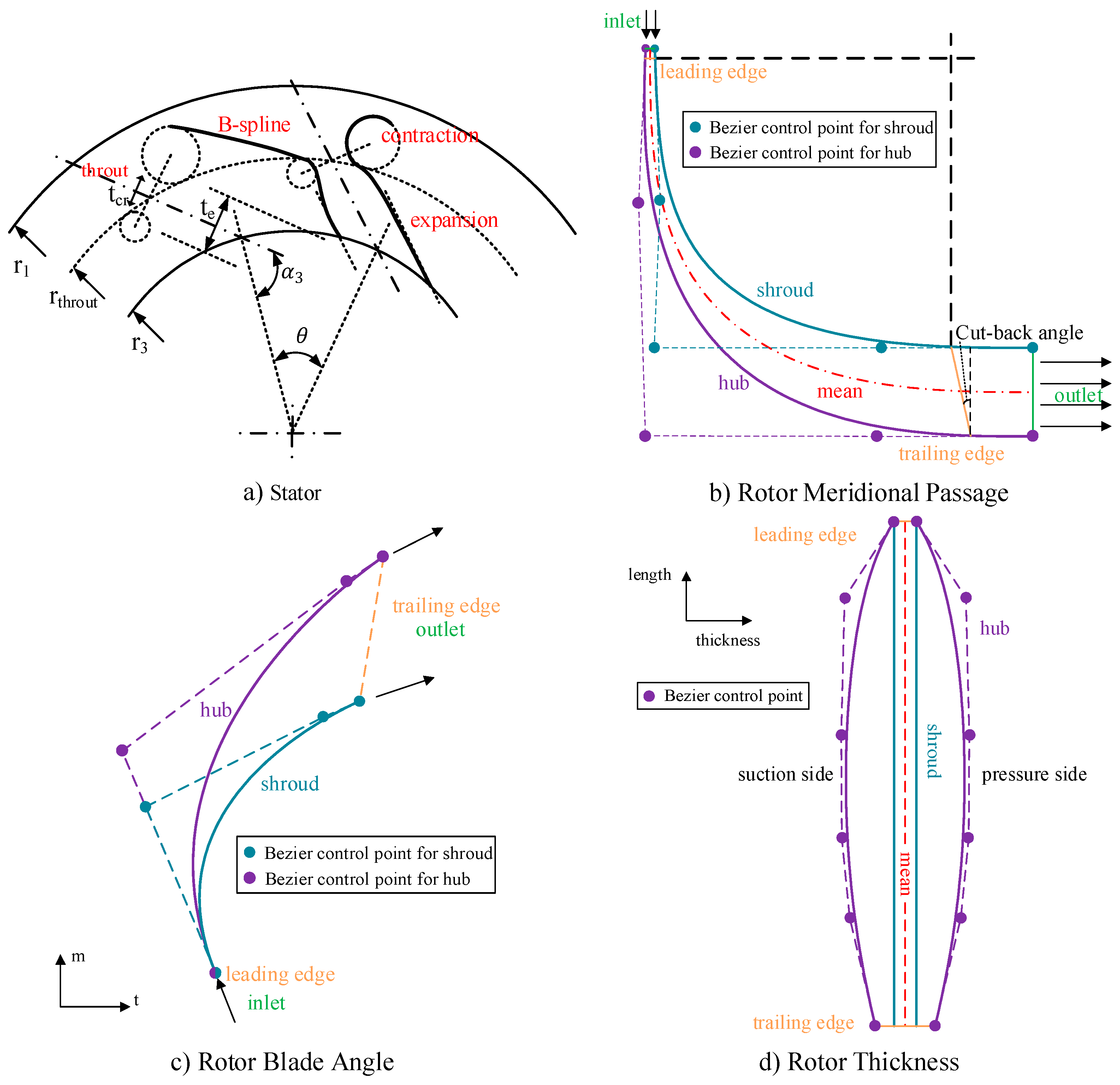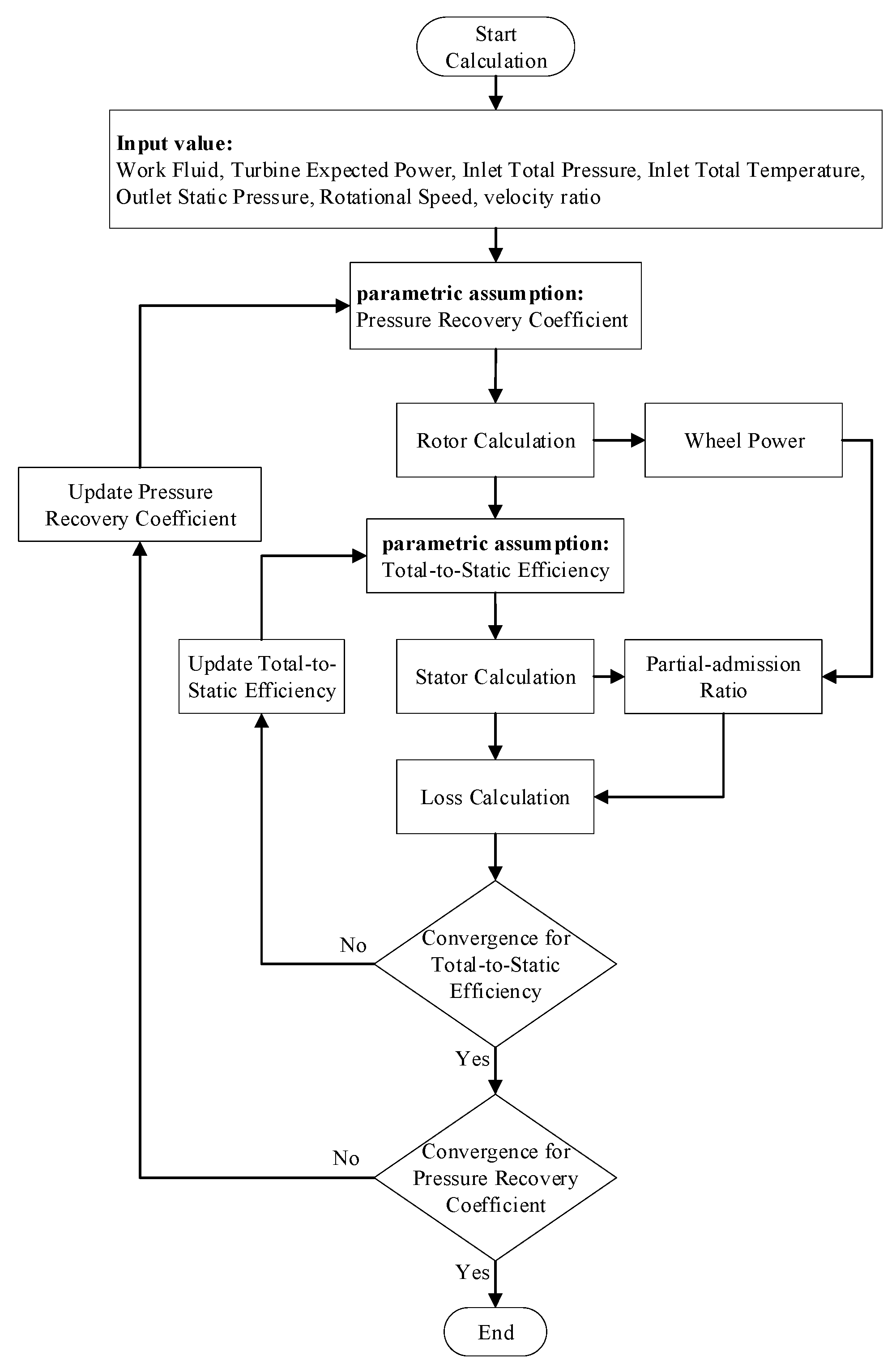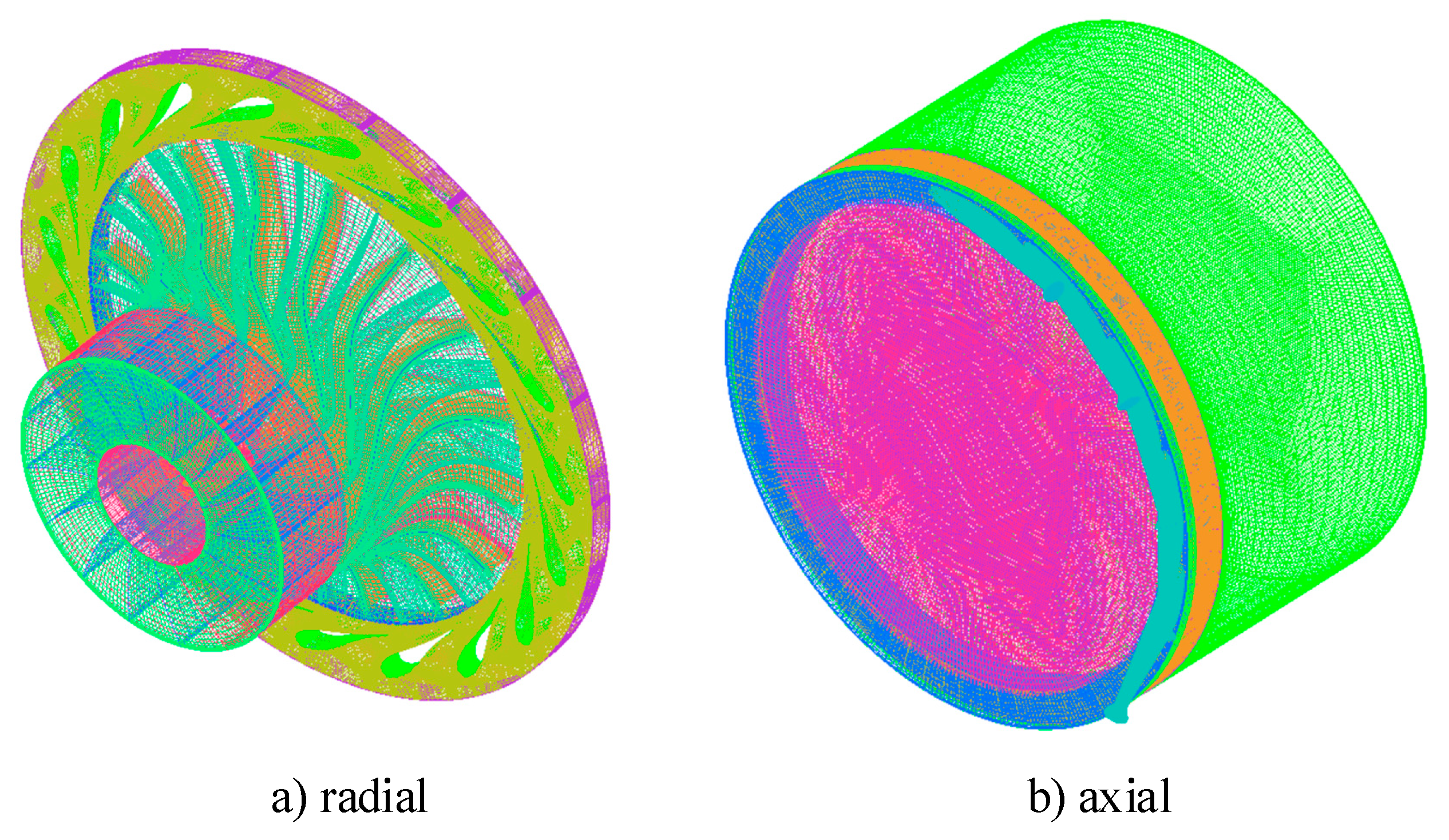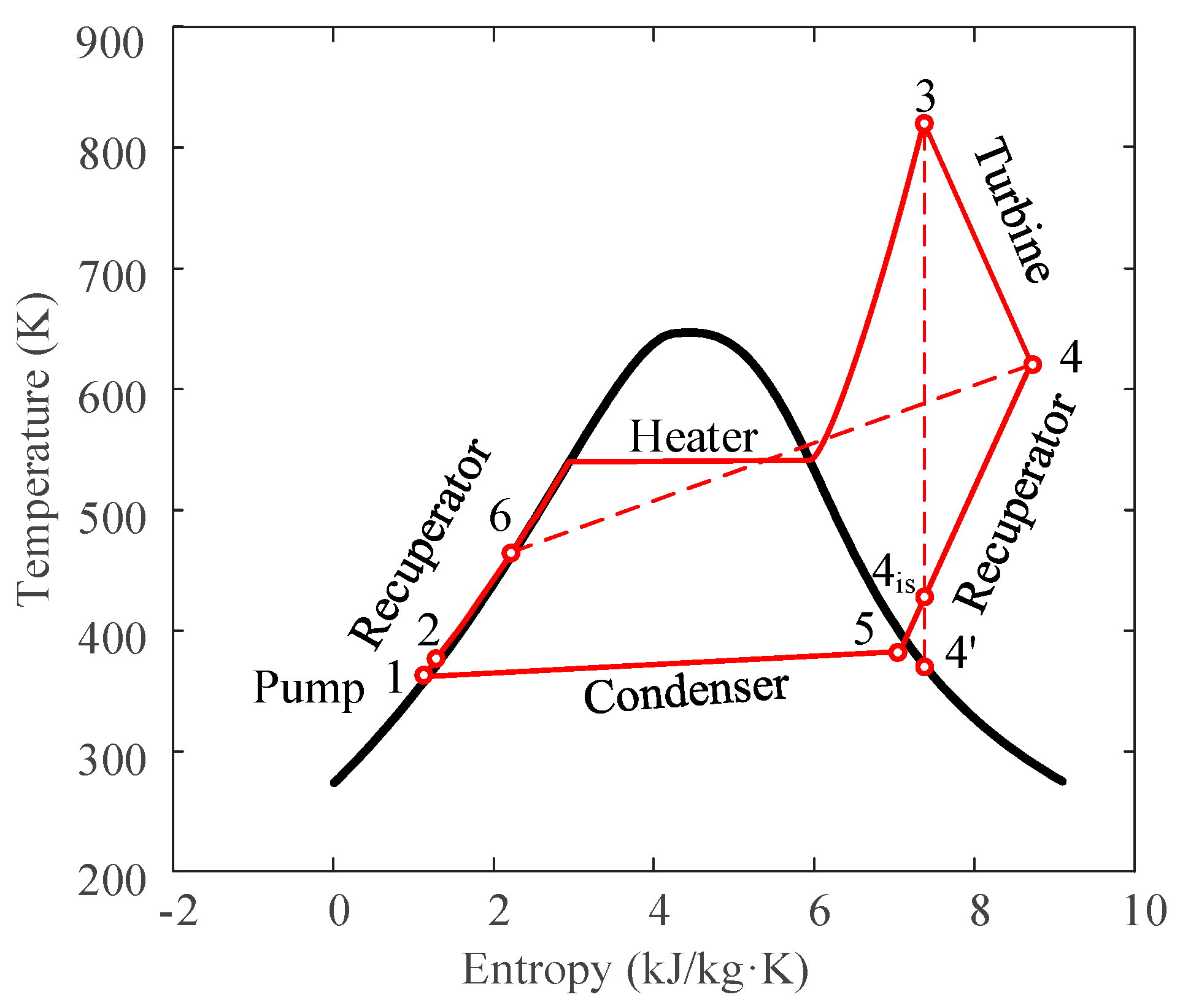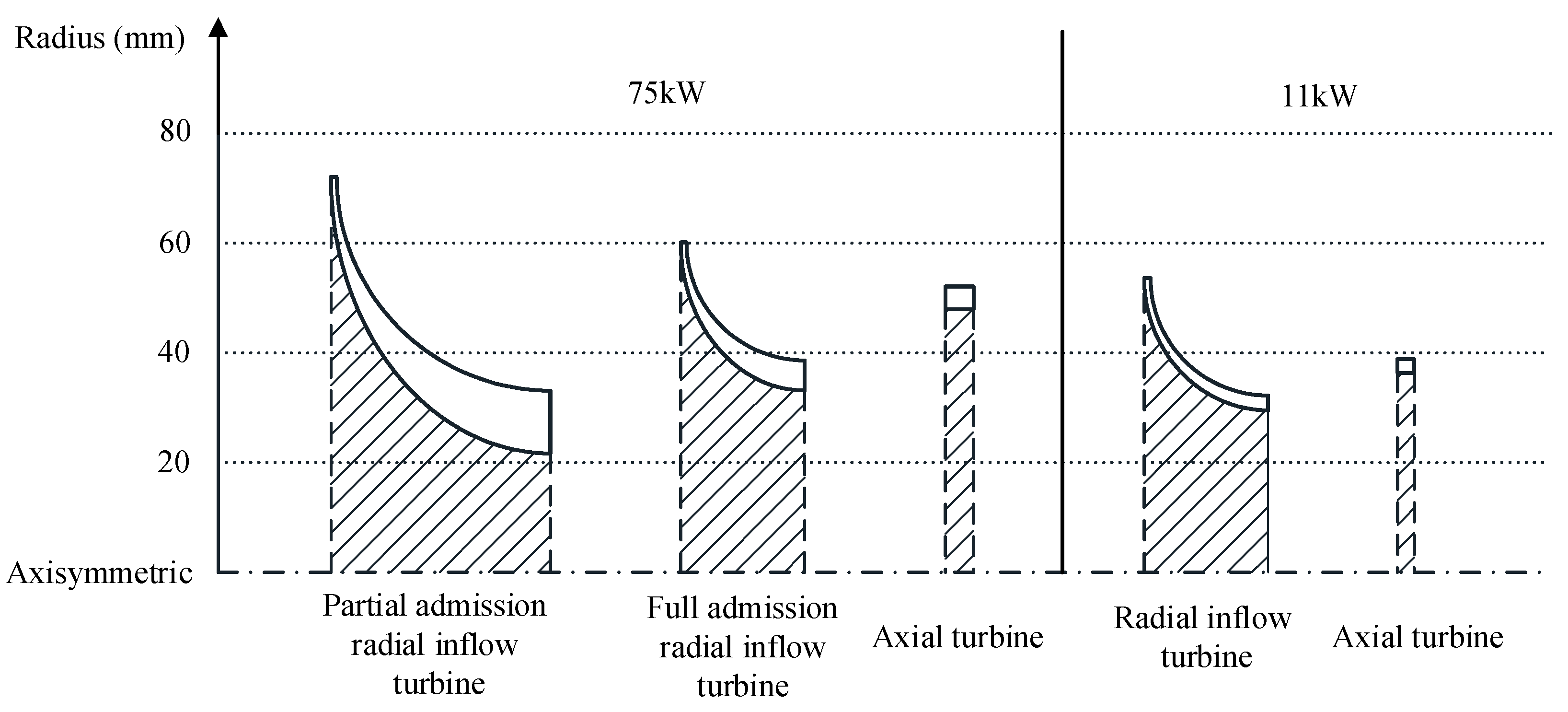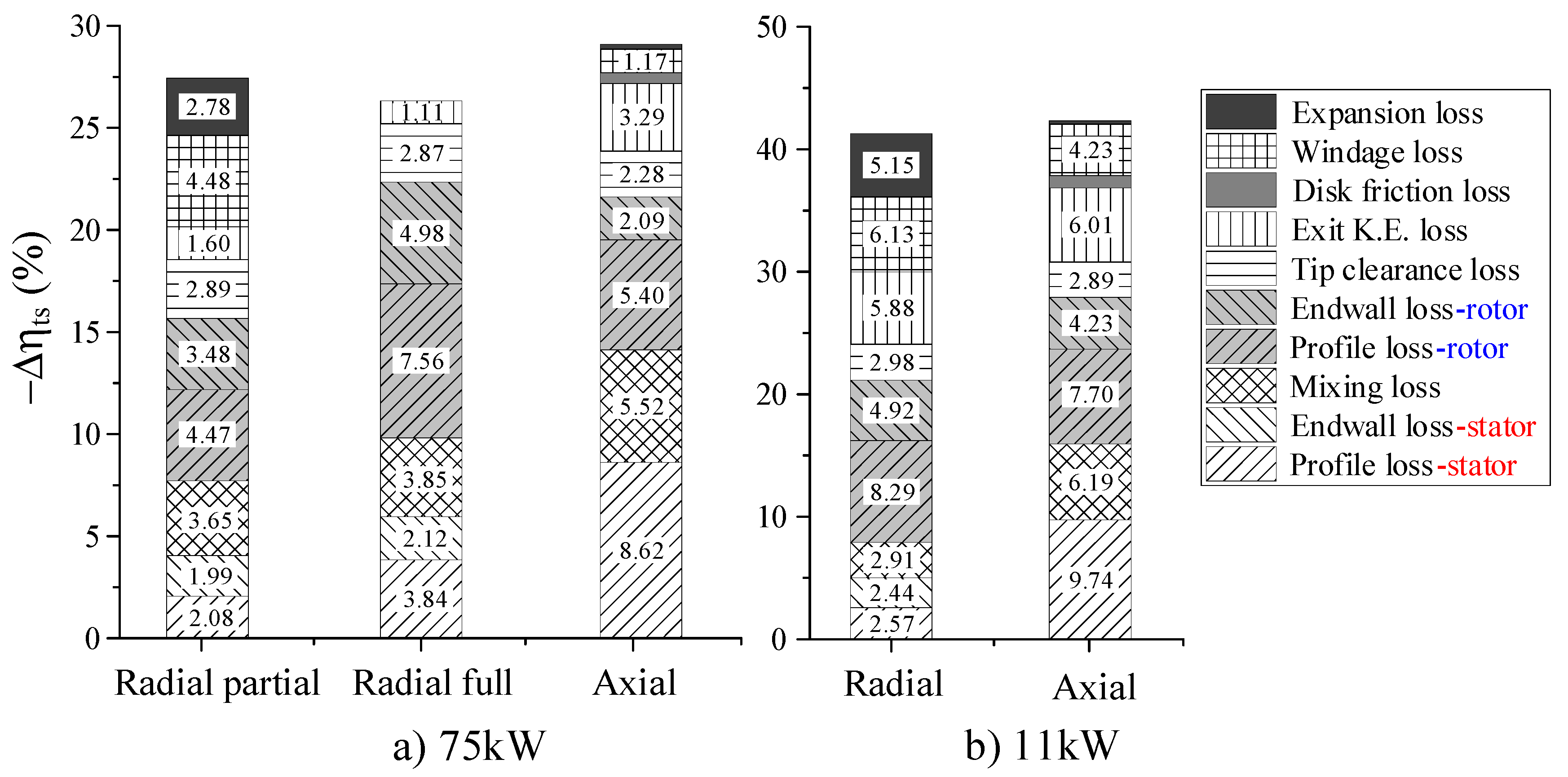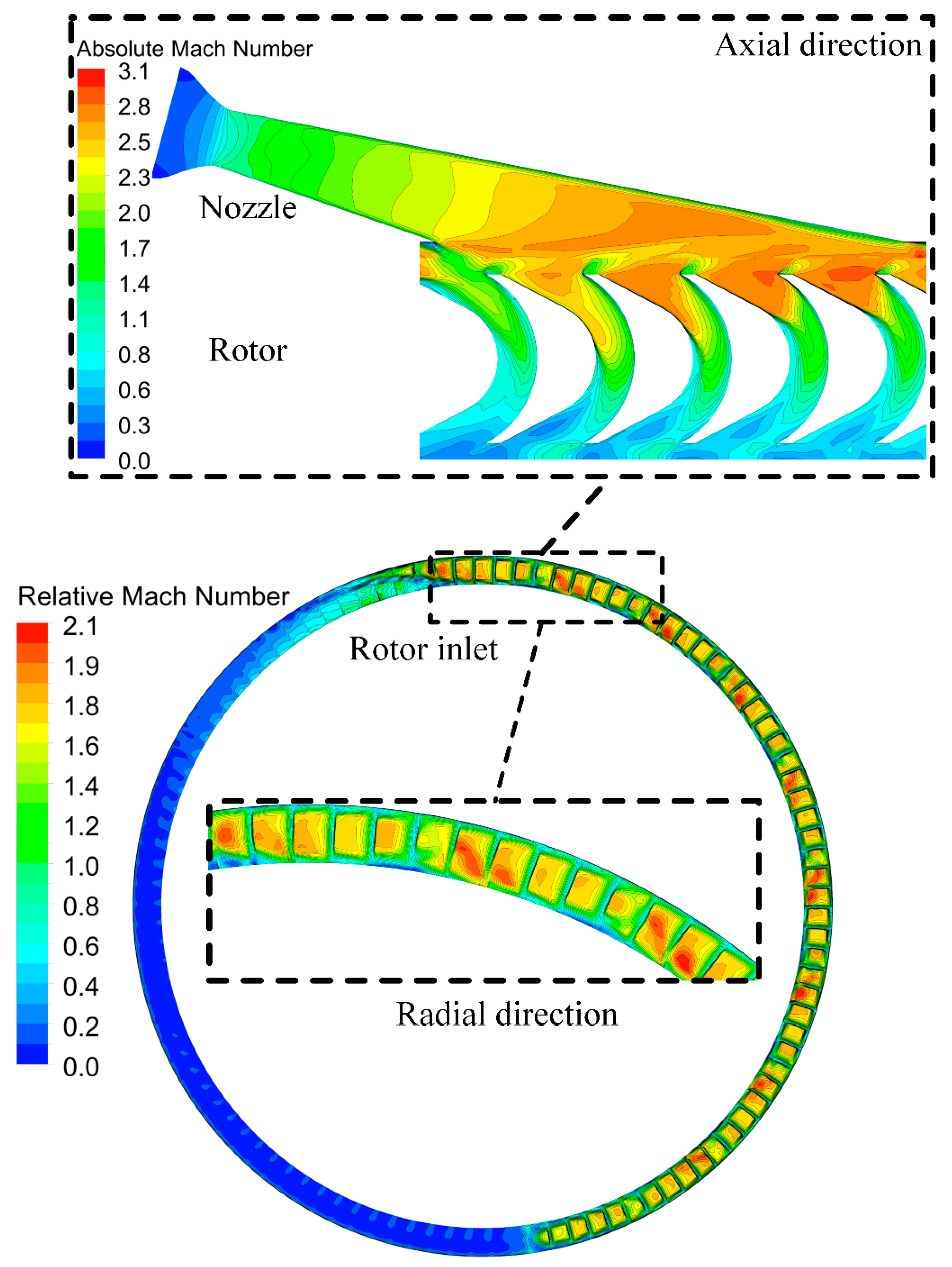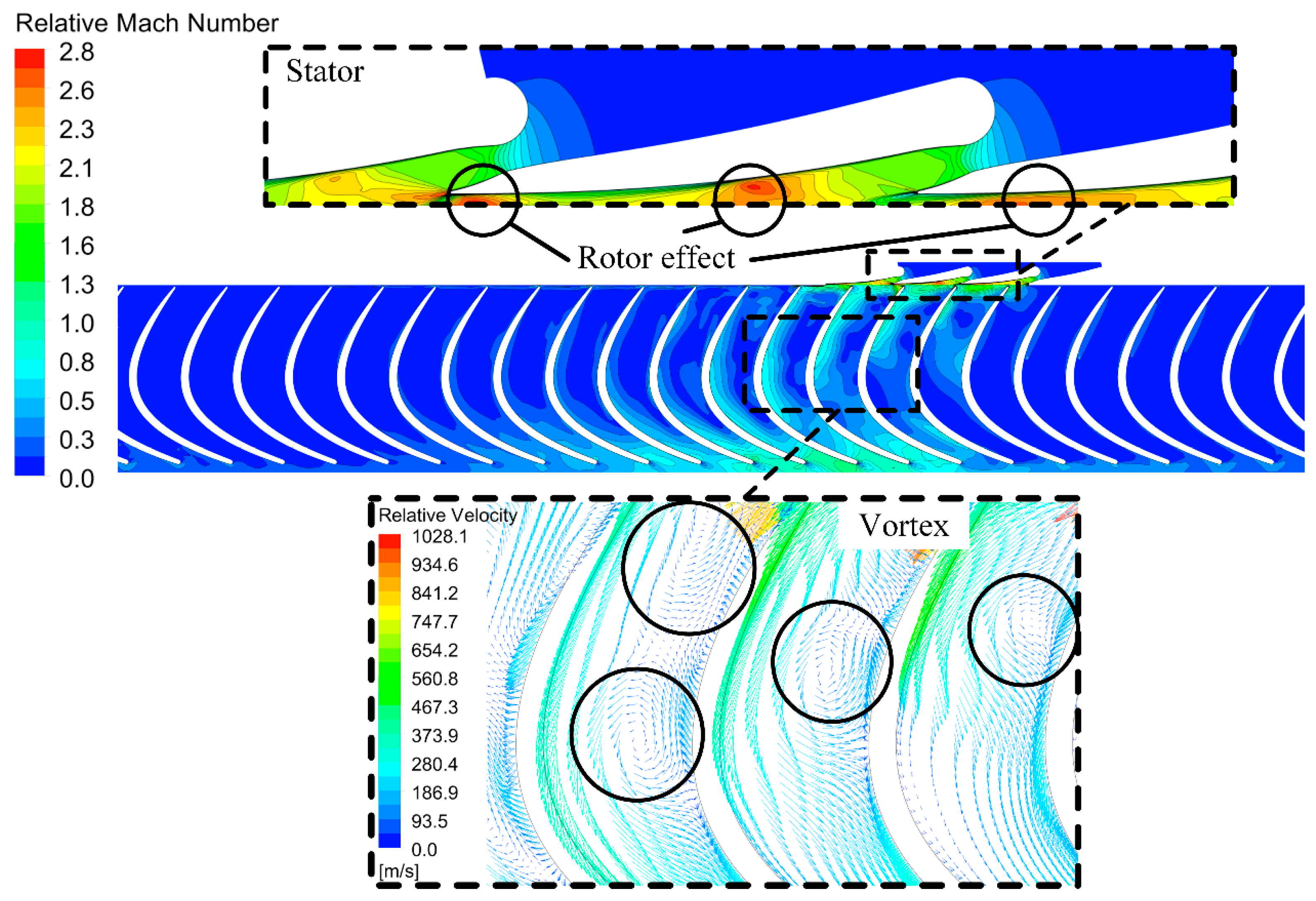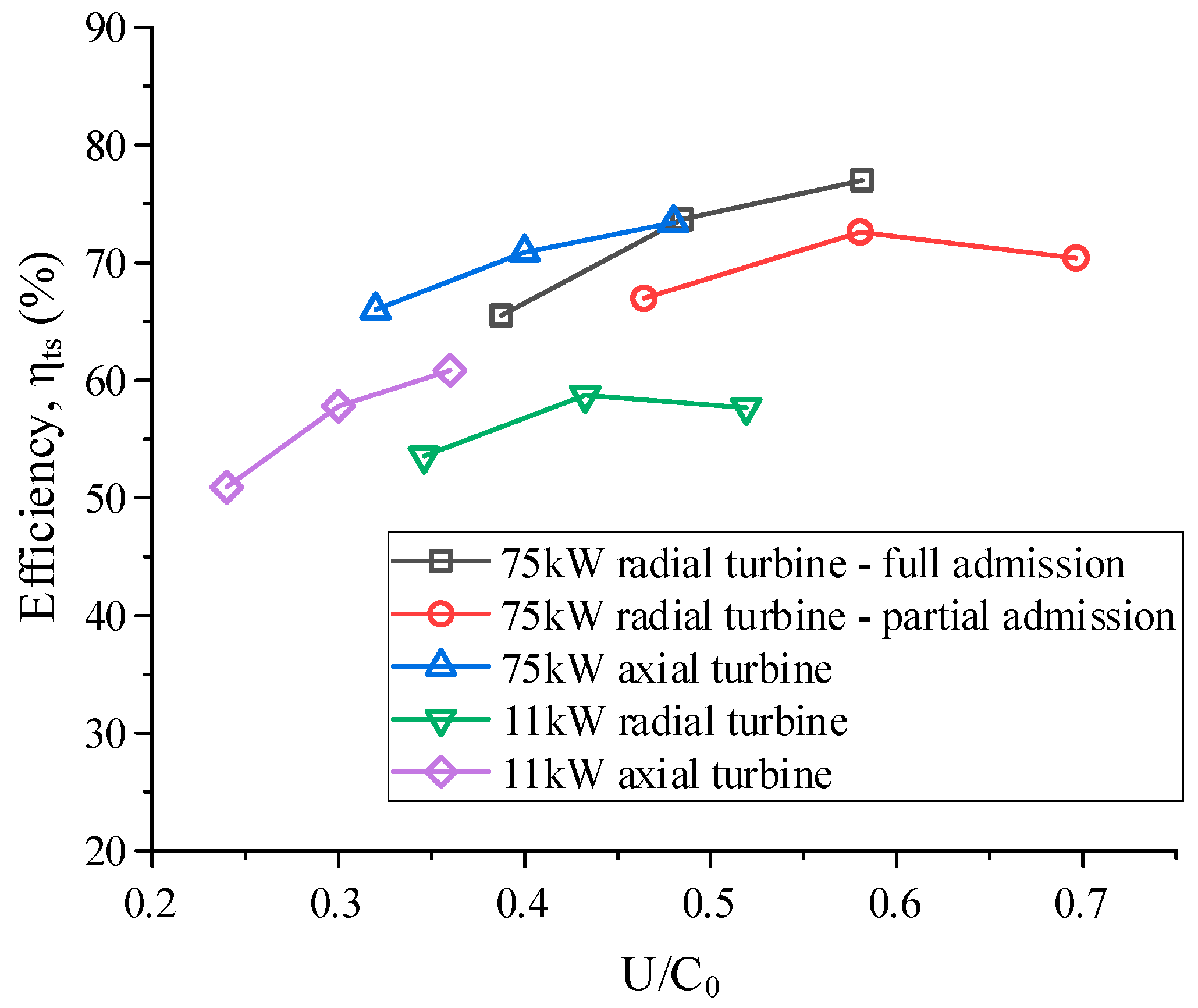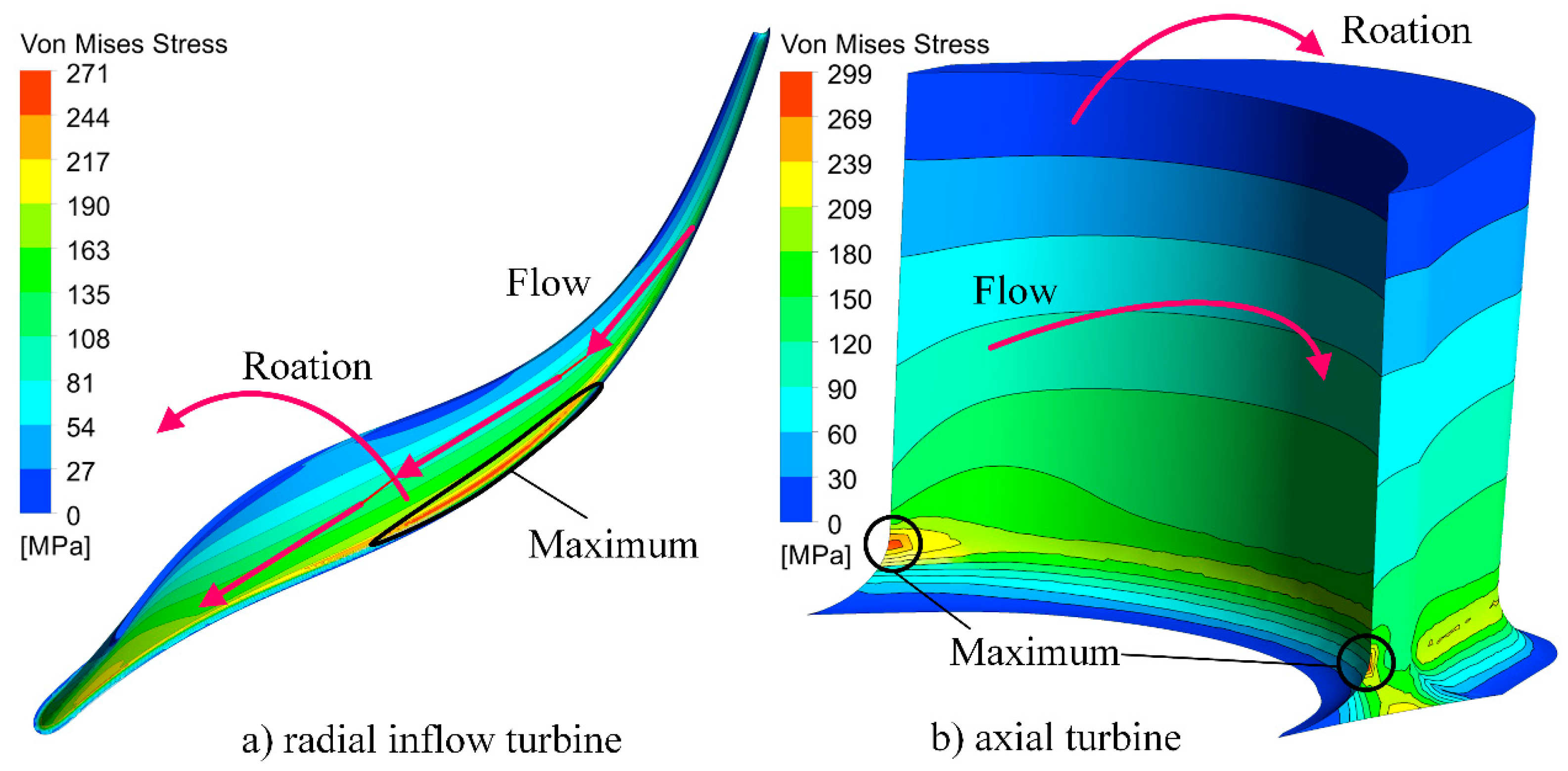Now both the mean-line and numerical methods are well validated, the performances of axial and radial inflow turbines are compared for underwater vehicles.
5.1. Mean-Line Design Result
The thermodynamic cycle of the proposed steam Rankine cycle for UUVs is shown in
Figure 6 [
43,
48]. Process 3–4 is the turbine expansion process, while 3–4 expresses the ideal isentropic expansion. As shown in
Figure 6, a turbine inlet temperature of 823 K is selected, while the inlet pressure is 5 MPa. The outlet pressure is approximately 0.2 MPa.
Two cases with different output powers (11 kW and 75 kW) are selected, and this corresponds to the different partial admission ratios. Design constraints [
43] are listed in
Table 3. The radial clearance of the rotor is equal to 0.1 mm [
49]. The thermodynamic properties are obtained from REFPROP 9.0.
For radial inflow turbines,
Figure 7a–c shows the contour of efficiency (black), partial admission ratio (red) and absolute rotor inlet flow angle (blue) obtained from the mean-line method. The rotor radius ratio ε is initially set as 0.3 [
24]. The flow coefficient 0.1 ≤ φ ≤0.3 and head coefficient 0.8 ≤ ϕ ≤2.4 are selected. The stator absolute velocity angle is limited to 80°. Therefore, the flow and head coefficients are selected as 0.2 and 1.2, respectively, as marked in
Figure 7a. In addition, the results from Baines [
28] and Ma [
50] show that the outlet radius of the radial inflow turbine needs to be increased in microturbine applications, and the rotor radius ratio ε is then changed to 0.55. As shown in
Figure 7b, the optimal flow and head coefficient are now chosen as 0.2 and 1.6. The partial admission ratio is larger than 0.8. The full-admission configuration can be realized by increasing the stator chord slightly. For the calculation of 11 kW, the rotor radius ratio ε is also set to 0.55, and the lower limit of ϕ is adjusted from 0.8 to 1.2 (see
Figure 7c). Generally, the full-admission efficiency of the radial inflow turbine is higher than 80% at the low flow coefficient (~0.8), resulting in the low partial admission efficiency with low partial admission ratio. With the decrease in the output power, the optimal flow coefficient will gradually increase (
Figure 7).
For axial turbines,
Figure 7d shows the calculation results of axial turbines and the selected optimal points. It is noted that the stator angle for the axial turbine is typically set as 15°. A velocity ratio between 0.2 and 0.6 is selected for high partial admission, while 0.2~0.4 is for the low partial admission. Similar to radial inflow turbines, the optimal velocity ratio is decreased with the decreased output power.
The mean-line design results are summarized in
Table A3 and
Table A4 in
Appendix B. The axial turbines present a high rotor number (five times the radial inflow turbine), and the edge thickness (0.21 mm for 75 kW and 0.13 mm for 11 kW) is smaller than radial inflow turbines (0.5 mm), which presents a negative influence on the strength performance.
Figure 8 shows the meridional plane of the designed turbines. It is found that axial turbines have advantages in size at both axial and radial directions. The structure of axial turbines is compact and it is more suitable for limited space application. Additionally, the axial turbines can facilitate a larger blade height compared to radial inflow turbines. For radial inflow turbines, the blade height gradually increases from the inlet to outlet. At the rotor outlet, the blade height is larger than the axial turbines. This configuration makes the radial inflow turbines have less mechanical stress when the blade height is increased. In addition, with an inlet blade height around 1 mm and supersonic inlet velocity for radial inflow turbines, it is extremely different from existing applications. The rotor experiences relatively large clearance losses, increased viscous losses and a partial admission effect, especially at 11 kW.
5.2. Aerodynamic Performance
The radial and axial turbines obtained from the mean-line method are further assessed with the high-fidelity CFD method, and the comparison is listed in
Table 4. Great agreement is achieved, and the relative difference is within 4%. It is shown that the performance of the radial inflow turbines is slightly higher than axial turbines. To provide more detail, the numerical loss breakdown study is performed based on the entropy rise at different surfaces with various computational setups. The losses are profile loss, endwall loss, mixing loss, tip clearance loss, exit kinetic energy loss and partial admission losses. The computational setup refers to Wheeler [
51], Keep [
52] and De Servi [
49].
Table 5 shows the method of the numerical loss break-down used in this paper.
The profile loss is determined as the entropy rise over each component due to the blade boundary layer, trailing edge, and shock. The tip clearance, windage loss and expansion loss are considered the efficiency difference between different computational setups. The tip clearance loss describes the mixing of leaked and mainstream fluid combined with the friction loss at the shroud of the blade. The windage loss is caused by the centrifuging of the dead gas in the non-working segment. The expansion loss reflects the transient effect of partial admission when reentering the non-working or working segment. In addition, the exit kinetic energy loss reflects the dissipated kinetic energy at the rotor outlet. As shown in
Table A3, the contribution of the disk friction loss to the total loss is less than 1%; therefore, the wheel is ignored in the radial inflow turbine modeling. Typically, the mixing-plane model is switched to the rotation-station interface. Due to the significant change at the interface caused by the shock wave and trailing edge wake, the loss decomposition of the rotor may be distorted. Therefore, the loss must also refer to the calculation results from the frozen rotor interface to achieve a reasonable result.
Figure 9 shows a loss breakdown of the radial and axial turbine at different powers with the data of the efficiency loss contribution exceeding 1%.
As shown in
Figure 9, the stator loss of radial inflow turbines (7.72% for 75 kW partial admission; 9.81% for 75 kW full admission; 7.92% for 11 kW) is lower than that of the axial turbine (14.14% for 75 kW; 15.93% for 11 kW). For axial turbines, since the stator trailing edge is cut-off and irregular, this results in a large stator loss and mixing loss (see
Figure 10). In addition, the straight-line shape of the expansion section makes the passage loss even higher. For radial inflow turbines, due to the longer chord of the stator after the expansion section, the flow at the outlet is greatly affected by the rotor leading edge, as shown in
Figure 11. However, due to the smaller stator exit absolute velocity of the radial inflow turbines (75 kW full admission: 1016 m/s; 75 kW partial admission: 951.5 m/s; 11 kW: 985.4 m/s), the stator loss is lower than the axial turbines (1174 m/s).
For rotor loss, the length of the rotor blades is significantly longer than the axial turbines (in
Figure 8), resulting in a decrease in efficiency of the radial inflow turbines due to the larger rotor passage losses at low velocity ratio (
Figure 9 rotor losses). As shown in
Figure 11, the working fluid only partially fills the rotor passage in the admitted channel because of the lower blade number and thinner rotor blade thickness. As shown in
Figure 11 (Velocity vector), the supersonic flow and high absolute angle at the rotor inlet create the enhanced secondary flow loss. However, in
Figure 10 Axial direction—Rotor, the flow in axial turbines is much smoother. Therefore, the loss caused by the blade shape of radial inflow turbines (7.56% for 75 kW full admission; 8.29% for 11 kW) is higher than the axial turbines (5.4% for 75 kW; 7.7% for 11 kW), while at 75 kW partial admission radial inflow turbine (4.47%), the profile loss is smaller due to the lower rotor inlet relative velocity.
The rotor loss of axial turbines cannot be further decreased, since the speed distribution of axial turbines with the circular-type stator at the rotor inlet is not uniform (
Figure 10 Radial direction), and the flow characteristics in different sections are greatly different. Therefore, although the flow is more uniform in the axial direction, the difference in the radial direction is still large. In addition, due to the high continuous blade height from the rotor inlet to outlet, the end wall (Radial inflow turbine: 3.48% for 75 kW partial admission; 4.98% for 75 kW full admission; 4.92% for 11 kW. Axial turbine: 2.09% for 75 kW; 4.23% for 11 kW) and tip clearance loss (Radial inflow turbine: 2.89% for 75 kW partial admission; 2.87% for 75 kW full admission; 2.98% for 11 kW. Axial turbine: 2.28% for 75 kW; 2.89% for 11 kW) of the axial turbines is lower than the radial inflow turbines. Moreover, the exit K.E. loss of radial inflow turbines (1.6% for 75 kW partial admission; 1.11% for 75 kW full admission; 5.88% for 11 kW) is smaller than the axial turbines (3.29% for 75 kW; 6.01% for 11 kW) because of the lower rotor exit radius. The 11 kW radial inflow turbine has a higher exit K.E. loss (5.88%) close to the axial turbine (6.01%) because of the blade height reduction at the rotor outlet.
The partial admission losses of the radial inflow turbines (7.26% for 75 kW; 11.28% for 11 kW) are significantly higher than the axial turbines (1.38% for 75 kW; 4.47% for 11 kW). The longer rotor blades of radial inflow turbines have a larger blade passage volume, which directly causes the increment of dead gas in the non-working segment. This leads to more centrifugal force to rotate the dead gas. Therefore, the windage loss for radial inflow turbines (4.48% for 75 kW; 6.13% for 11 kW) is higher than the axial turbines (1.17% for 75 kW; 4.23% for 11 kW) (
Figure 9). The strong transient effects in the rotor lead to an extremely high loss. When the rotor enters the working segment, the dead gas needs to be pumped out. Due to the larger volume of dead gas and longer blades in the radial inflow turbine passage, more energy is required to push the dead gas out of the turbine. Radial inflow turbines are inferior in terms of partial admission losses. However, because of the higher full-admission efficiency, the efficiency with a partial admission structure is not much different from the axial turbine.
The turbine off-design performance is also essential for the UUV power system.
Figure 12 shows the variation in the total-to-static efficiency as a function of the velocity ratio. The results are calculated by keeping the pressure ratio constant while varying the rotational speed from 80% to 120% of its nominal value. For the full-admission radial inflow turbine, it is not suitable at a velocity ratio under 0.5. For partial admission radial inflow turbines, the efficiency is still higher than axial turbines at the low rotational speed. However, with the rotor inlet diameter of radial inflow turbines further increasing the velocity ratio, the axial turbines still have a great advantage at low velocity ratio.
5.3. Strength Comparison
To evaluate the strength performance, the von Mises stress distribution is determined by the ANSYS Structural module. The blade is made of a nickel chromium INCONAL 718 [
24] material with a mass density of 8220 kg/m
3. The Young’s modulus and Poisson’s ratio of the material are 127 GPa and 0.4, respectively. A fixed support condition is set at the hub of the blade, and a rotation speed of 100,000 rpm around the z axis is also prescribed. In addition, the aerodynamic force is then considered by full admission steady-state node pressure transformed from fluid to structure.
The structural analysis results show that the maximum equivalent stress of radial inflow turbines is smaller than axial turbines (see
Table 6). The distribution of von Mises stress of the blade is shown in
Figure 13. The maximum Von Mises stress for radial inflow turbines is at the middle of the blade, while for axial turbines it is at the leading and trailing edge of the blade. The result shows that although the radius at the rotor inlet is the highest, the lower inlet blade height of the radial inflow turbines results in the smaller centrifugal force. Similarly, the hub radius is small at the exit with the highest blade height; therefore, the strength is still small. Therefore, the radial inflow turbine can have a higher speed ratio than the axial turbine under better stress conditions. However, the radial inflow turbine requires the proper blade profile design to achieve this result. Sometimes, undesirable design not only affects turbine efficiency, but also concentrates stress at the inlet or outlet like the axial turbine. In addition, since the blade height for 11 kW is smaller than the 75 kW (
Table A3 and
Table A4), the torque generated by the supersonic flow on the bottom of the blade will be reduced. Therefore, the influence of aerodynamics decreases with the reduction in the output power.
